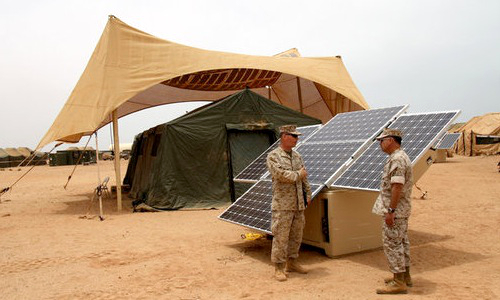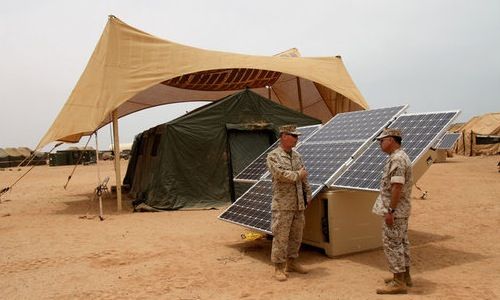

By Alex Straub and Michael Timberlake
With the excitement of a long weekend it’s easy to lose sight of what this extra vacation day is really about. Today, Veteran’s Day, offers a specific opportunity to express our gratitude for the sacrifices military men and women make every day across the country. As one of our country’s most vital valuable assets, the military and its missions and tactics are frequently discussed and praised.
But often left unnoticed is the military’s growing leadership on the energy front.

We trust the military to protect our nation, family and friends, so it should come as no surprise that we often seek its guidance in areas outside of combat. The Hummer’s hulking 8 miles per gallon transition from the battlefield to civilian life is just one (fairly regrettable) example. However, after the Hummer’s short-lived popularity (one would have to assume was largely due to the skyrocketing cost to fill up its 32-gallon tank), the U.S. Army and Navy, the Department of Defense (DOD), the Department of Veterans Affairs, and other military organizations have made advancing their energy efficiency a central objective.
A few highlights of these commendable efforts include:
- In 2011, the DOD began implementing smart electricity meters in U.S. Navy buildings to gather information to reduce energy usage.
- The Navy’s 1 Gigawatt Task Force has the goal of generating 1 gigawatt of renewable energy by the end of the decade. President Obama called it, “one of the largest commitments to clean energy in history.
- The Army adopted a “Net Zero Energy” program in April 2013 with the goal of producing the same amount of energy that is used by the organization.
- Most recently, the Department of Veterans Affairs was ranked number 2 on the Top 10 Federal Government Partner List by Green Power Partnership for making green power purchases resulting in emissions reductions and electricity savings.
- The DOD also plans to buy 92,000 hybrid and electric vehicles over the next seven years to trim its nearly $20 billion fuel bill.
- In August, the DOD allocated $4.3 million toward technological initiatives aimed to boost efficiency out in the field, including reducing drag on aircraft, developing tactical microgrids standards to speed adoption, and reducing the quantity, weight, and reliability of batteries used by troops.
- Integrating generators into a variety of military electric vehicles (both combat and non-combat) that can supply electricity to the grid and provide their battery power to numerous operations.
Senator Mark Warner (D-Va.) is just one politician who believes efficiency is important for the Armed Forces and has championed those efforts over his Senate career. At a Senate Energy Committee Hearing in 2012 he said, “[energy conservation in the military] is about saving money … and saving lives.” Warner understands that increasing energy productivity improves military capability, lowers costs, and increases unit self-sufficiency and performance while protecting supply lines—which ultimately increases safety for our soldiers.
By implementing greater energy efficiency practices, government agencies, businesses, and individuals can see lower energy costs and increased performance in a similar way. Active military personnel in combat zones see the impact of energy efficiency practices more quickly and directly than the average civilian who isn’t necessarily worried day to day about the risks of transporting fuel or the energy needed to maintain essential operations—but the benefits of adopting these practices are real and tangible nonetheless.
Energy efficiency has clearly become a top priority for our Armed Forces, but it’s high time we move beyond praise and follow the lead of our men and women in uniform by embracing energy efficient technologies, policies, and practices at home as well as on the battlefield.
Visit EcoWatch’s RENEWABLES page for more related news on this topic

 233k
233k  41k
41k  Subscribe
Subscribe 
